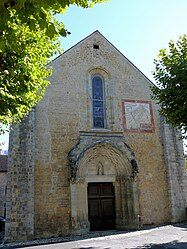Senez
Senez Seneç (Occitan) | |
|---|---|
 The cathedral of Our Lady of the Assumption, in Senez | |
| Coordinates: 43°54′52″N 6°24′28″E / 43.9144°N 6.4078°E | |
| Country | France |
| Region | Provence-Alpes-Côte d'Azur |
| Department | Alpes-de-Haute-Provence |
| Arrondissement | Castellane |
| Canton | Riez |
| Government | |
| • Mayor (2020–2026) | Gilles Durand[1] |
Area 1 | 70.27 km2 (27.13 sq mi) |
| Population (2021)[2] | 158 |
| • Density | 2.2/km2 (5.8/sq mi) |
| Time zone | UTC+01:00 (CET) |
| • Summer (DST) | UTC+02:00 (CEST) |
| INSEE/Postal code | 04204 /04330 |
| Elevation | 748–1,720 m (2,454–5,643 ft) (avg. 780 m or 2,560 ft) |
| 1 French Land Register data, which excludes lakes, ponds, glaciers > 1 km2 (0.386 sq mi or 247 acres) and river estuaries. | |
Senez (Occitan: Seneç) is a rural commune in the Alpes-de-Haute-Provence department in the southeastern Provence-Alpes-Côte d'Azur region in France.
Ecclesiastical history
Marcellus I, the first known bishop of Senez, attended the Council of Agde in 506 CE; nevertheless, Senez must have been an episcopal city as early as 439 CE.
Jean IV Soanen, the Oratorian, noted for his opposition to the Bull "Unigenitus", was Bishop of Senez from 1696 until the time of his deposition in 1727.
By the Concordat of 1801, the diocese of Digne was made to include the two departments of the Hautes-Alpes and Basses Alpes, in addition to the former diocese of Digne, the archdiocese of Embrun, the dioceses of Gap, Sisteron, and Senez, a very considerable part of the diocese of Glandèves and diocese of Riez, and fourteen parishes in the Archdiocese of Aix and the Diocese of Apt.
In 1822 Gap was made an episcopal see and, thus divested of the department of the Hautes Alpes, the present diocese of Digne covers the territory formerly included in the dioceses of Digne, Senez, Glandèves, Riez, and Sisteron.
Demographics
| Year | Pop. | ±% p.a. |
|---|---|---|
| 1968 | 182 | — |
| 1975 | 134 | −4.28% |
| 1982 | 153 | +1.91% |
| 1990 | 121 | −2.89% |
| 1999 | 145 | +2.03% |
| 2009 | 179 | +2.13% |
| 2014 | 166 | −1.50% |
| 2020 | 161 | −0.51% |
| Source: INSEE[3] | ||
See also
References
- ^ "Répertoire national des élus: les maires". data.gouv.fr, Plateforme ouverte des données publiques françaises (in French). 2 December 2020.
- ^ "Populations légales 2021" (in French). The National Institute of Statistics and Economic Studies. 28 December 2023.
- ^ Population en historique depuis 1968, INSEE




